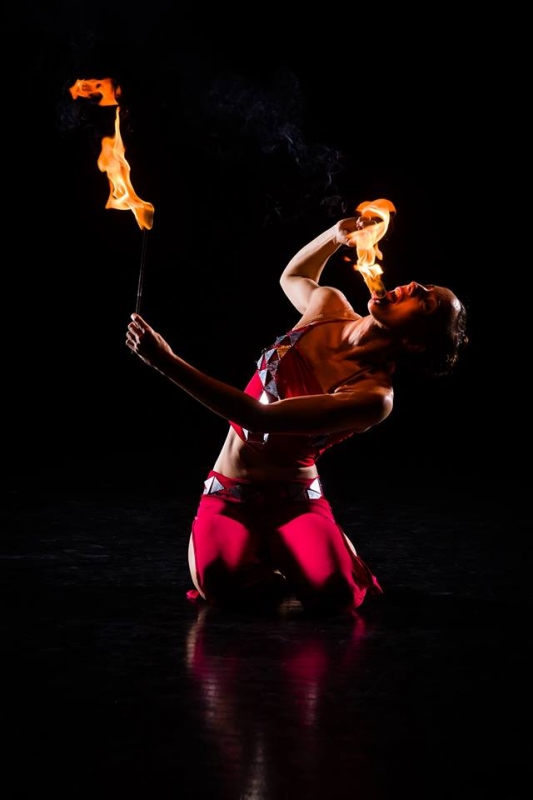Sambo Fogo’s Inspiraçâo Do Fogo @ Rose Wagner Performing Arts Center 04.03-05
Art

Samba Fogo continues its 2013-2014 recital with a performance of Inspiraçâo Do Fogo (Inspiration of Fire), a series of performances taking place April 3-5, at the Rose Wagner Performing Arts Center. Thursday’s show took place before a less-than-full house, though this did not prevent both the performers and audience members from immersing themselves completely in the event.
Sambo Fogo, in addition to presenting Brazilian dance as fine art, also shows a clear commitment to the non-formal aspects of dance, specifically its capacity for improving cultural awareness and fostering social relations. In line with this, the company warmly encourages spontaneous audience response and interaction with its work, while the work is being performed. Thursday’s crowd did not fail to applaud, cheer, and rise to its feet at key moments during the evening.
Inspiration begins with a presentation of the gods of the Brazilian Orixa religion. A series of dancers took the stage, each dressed as one of the deities. Most of the evening’s performance consisted of ensemble dancing. However, this opening section allowed soloists to take the stage and display a broader repertoire of movements and moods. These ranged from celebratory to mysterious. My only disappointment here was that each vignette proved to be inexplicably brief. No sooner did one settle into a particular character and dance than it came to a halt. I would have preferred each of these pieces to last at least a little longer, even if that meant trimming down other components of the show.
While Inspiration never wanted for color or verve, many of the conventions of Brazilian dance have begun to seem just that, conventional. One is by now familiar with the spectacle of capoeira combatants and samba dancers. To say this is hardly to detract from the very visible skill and enthusiasm of the performers themselves. However, one had to look elsewhere in the show for actual surprises. Fortunately, this need was met by the occasional utilization of ceremonial garb and ritual movement clearly displaying the West African origins of Brazilian culture and dance. Adding to the authenticity of the event was the participation of Bàbá Awòró Ösun, an intiated Orixa and Yoruba priest, who lead the company through songs and processional dances. Though there were certainly flashier moments in the show—especially some entailing the use of live fire—it was these less familiar components which stood out to me as the highlights of the evening. I would have been pleased to see even more of them.
Years of dedicated practice, as a performer and choreographer, have allowed Artistic Director Lorin Hansen to shape her company of dancers into an undeniably tight ensemble. Not only is this impressive in itself, but the air of overall control and confidence evinced by the group permits individual dancers to display a personal flair and freedom of individual expression which might appear out of line in a less disciplined company. It’s the balance struck between structure and drift which keeps the performance constantly intriguing.
As for music, this show differed from previous Samba Fogo performances insofar as it focused almost exclusively on ensemble percussion. While percussion is the soul of Brazilian music, typical Samba Fogo performances also employ stringed instruments to accompany numerous vocal numbers. In this show, however, drums dominated. Of particular interest to me were the complexity of the drumming patterns, which showed degree of intricate syncopation almost approaching that of avant-garde composer Steve Reich. Just as Hansen has constructed an especially cohesive body of dancers, Musical Director Mason Aescherbach has taken the integrity and energy of his drum core to the next level.
The official performance culminated in a Carnaval-style samba routine, with dancers in full regalia. This sort of finale is always a crowd-pleaser, and the dancers seemed to take as much pleasure in performing as the audience did in admiring their talent. The enthusiasm and good will of Samba Fogo was as abundant as ever Thursday night. And it is this visible love of their art which has made them so popular with their audience. Indeed, as a way of closing the gap between audience and performers, the company, following the official end of the show, greeted its guests in the Rose Wagner lobby. Still in costume, they continued to drum and dance, as if participating in a real street performance. While every dance company strives diligently to build up a base of loyal fans, I imagine there are very few so committed to engaging their audience on a personal level.
Inspiraçâo Do Fogo runs through April 5 at the Rose Wagner Performing Arts Center. The company offers lessons and workshops in various styles of Brazilian dance throughout the week. The Salt Lake cultural scene is fortunate to have a dance company at once so disciplined and so approachable. One hopes word of Samba Fogo spreads and their audiences become ever larger.


